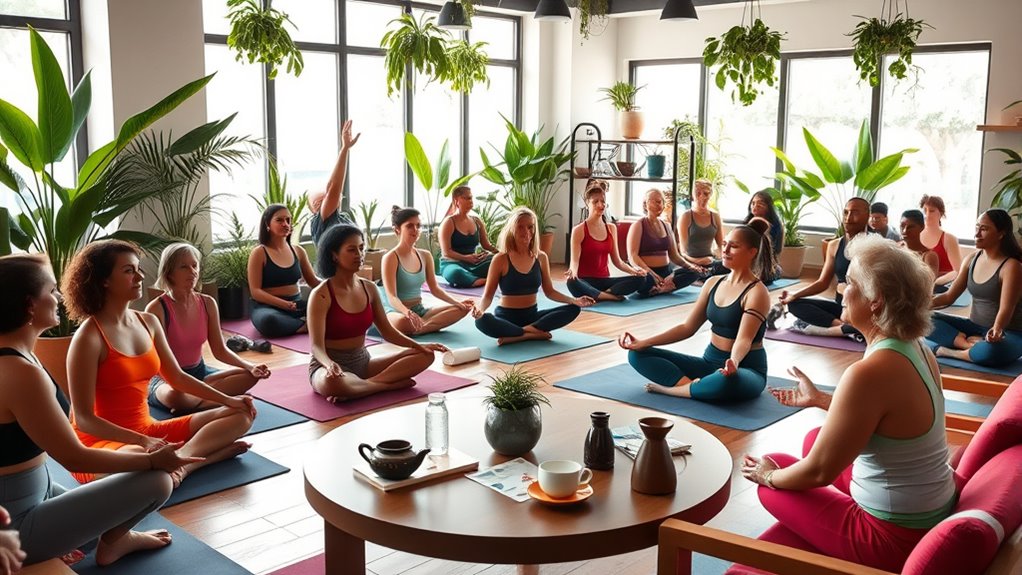Joining wellness clubs allows you to benefit from social support and health advocacy, creating a motivating environment where you can share experiences, encourage others, and stay committed to your goals. By participating in group activities and accessing expert advice, you’ll build confidence, emotional resilience, and a sense of community. Social approaches make health a shared effort, increasing your chances of lasting success. Keep exploring to discover how these connections can transform your wellness journey.
Key Takeaways
- Peer support fosters belonging, motivation, and emotional resilience within wellness clubs.
- Collective encouragement and camaraderie enhance commitment and accountability among members.
- Health advocacy promotes awareness, informed choices, and knowledge sharing to sustain healthy habits.
- Combining peer support and advocacy creates a supportive environment that nurtures confidence and progress.
- Social approaches transform wellness into a community effort, boosting confidence and ensuring long-term success.

Have you ever wondered how wellness clubs foster a sense of community while helping members achieve their health goals? One of the key ways they do this is through peer support. When you join a wellness club, you’re not just signing up for gym equipment or classes—you’re becoming part of a network of individuals who share similar health ambitions. This environment encourages you to connect with others, share experiences, and motivate each other. Peer support creates a sense of belonging, making your fitness journey less lonely and more motivating. When you see others working toward their goals, it fuels your determination. Plus, having people who understand your struggles and celebrate your victories adds emotional strength, which is *vital* for long-term success.
Peer support in wellness clubs fosters belonging, motivation, and emotional strength for long-term health success.
Alongside peer support, wellness clubs often emphasize health advocacy. This means they actively promote awareness and understanding of health issues, empowering members to make informed choices. When you’re part of a wellness community, you’re encouraged to ask questions, seek guidance, and advocate for your well-being. The staff and fellow members can serve as advocates, sharing knowledge about nutrition, mental health, or specific exercise routines. This collective effort helps break down barriers to health, making it easier for you to adopt sustainable habits. The emphasis on health advocacy also fosters a culture of mutual encouragement, where members support each other not just through words but through active participation in health-promoting activities.
What makes wellness clubs particularly effective is how they blend peer support with health advocacy. Imagine attending a group workout session where members cheer each other on, or participating in a health seminar led by knowledgeable staff. You’re not only receiving expert advice but also experiencing the power of community-driven encouragement. This dual approach ensures that your motivation is sustained, and you feel backed by a network that genuinely cares about your progress. The community atmosphere also encourages accountability; you’re more likely to stick to your goals when others are counting on you and when you see the shared commitment of the group. Incorporating organized space and effective storage solutions can further enhance the environment by making it more welcoming and functional.
In the end, wellness clubs thrive because they recognize that health isn’t just about individual effort—it’s about collective support and shared knowledge. Peer support boosts your confidence and provides emotional reinforcement, while health advocacy ensures you’re well-informed and empowered. Together, these social approaches create a vibrant environment where you’re motivated, supported, and inspired to reach your health goals. When you’re part of such a community, wellness becomes a shared journey, and success feels more achievable.
Frequently Asked Questions
How Do Wellness Clubs Tailor Programs for Diverse Community Needs?
You can tailor wellness club programs by focusing on cultural sensitivity and personalized approaches. Listen to your community’s unique needs, traditions, and preferences, then design activities that respect these differences. Offer diverse options, language support, and flexible schedules to guarantee inclusivity. By actively engaging members and adapting programs accordingly, you create a welcoming environment that promotes better health outcomes for everyone, regardless of their background.
What Funding Sources Support Community-Based Wellness Initiatives?
You can access funding for community-based wellness initiatives through grant opportunities from government agencies, foundations, and local organizations. Public-private partnerships also play a crucial role, allowing you to collaborate with businesses and nonprofits to pool resources. These sources provide essential financial support, enabling you to develop and sustain programs that meet diverse community needs and promote health and well-being effectively.
How Is Member Privacy Maintained in Social Health Activities?
You keep member privacy safe by following strict confidentiality protocols and prioritizing data security. You guarantee personal details are only shared with authorized staff and stored securely, preventing unauthorized access. Using anonymized data for group activities also helps protect identities. These measures foster trust, allowing members to participate openly, knowing their privacy is respected and protected at all times.
What Metrics Measure Success in Community Wellness Programs?
You can measure success in community wellness programs through program engagement, which shows how actively participants participate, and health outcome metrics like improved fitness levels, reduced health risks, or better mental health scores. Tracking participation rates, feedback surveys, and health data helps you see progress over time. When these metrics improve, it indicates your program effectively promotes healthier behaviors and positive community health outcomes.
How Can Newcomers Effectively Integrate Into Wellness Club Communities?
To effectively integrate into wellness club communities, focus on embracing cultural integration by participating in group activities and respecting diverse backgrounds. Overcome language barriers by practicing active listening, using simple phrases, or seeking translation support. Engage with others sincerely, show genuine interest, and attend regular events to build connections. This proactive approach helps you feel welcomed, fosters mutual understanding, and makes your integration smoother and more meaningful.
Conclusion
By joining wellness clubs and engaging with your community, you’re not just improving your health—you’re building meaningful connections. Did you know that people who participate in community-based health activities are 30% more likely to stick with their wellness routines? So, get involved, stay active, and enjoy the social support that makes health journeys easier and more rewarding. Your community isn’t just where you live; it’s your biggest ally in wellness.










